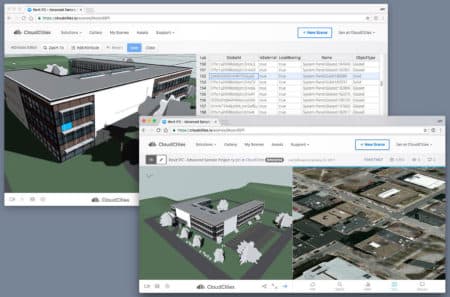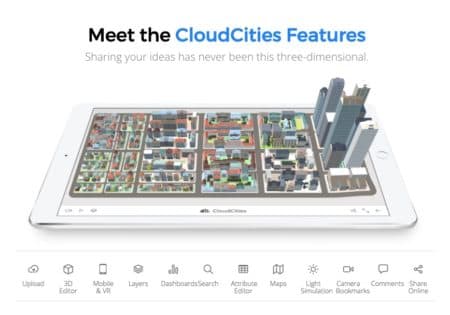BIM has never been very good at showing you where the data actually lives. Perhaps this is why architects the world over have often struggled to embrace the “I” (for information) in BIM in the first place?
As a group, architects are notorious for hanging on to using Excel to manage data. It has long been the tool they know. It is not that architects don’t want to get behind the concepts of “data” in BIM but rather having a familiar way of approaching data in the first place is vital to getting that information into the 3D model.
Paradox Solved
This is where CloudCities steps in, a small but important new cloud-based software company from Switzerland with an office in Silicon Valley.
Led by co-founders Antje Kunze (CEO) and Jan Halatsch, CloudCities confronts bespoke workflow problems across an array of related industries, including architecture, urban and campus planning, real estate and facility management. And one of its best features is how it is revolutionizing the 3D data mashup concept using a tool that architects already know—the spreadsheet.

01- This image of CloudCities running in a web browser on macOS shows the side-by-side attributes editor in the upper section of the view. Image: CloudCities, All rights reserved.
Known as the new Attributes Editor, the new feature in CloudCities serves to link spreadsheet data to 3D models. Whether architectural BIM models or general 3D models of buildings in urban or campus master plans, architects can view model data side-by-side with a spreadsheet. The spreadsheet itself, of course, works similarly to how all spreadsheets works—importantly you can add data columns and “link data” to model objects.
Data, Dashboards and A Growing App
The larger purpose of CloudCities is collaboration around data. Regardless of which industry above you come from, building data in the form of 3D models with attached metadata can be visualized strategically around that data. These strategic views can then be shared with stakeholders and collaborators.
In the recent update to CloudCities, the company announced IFC support. Jan Halatsch told Architosh that CloudCities reads in both IFC 2×3 and IFC 4 files. “Users can decide during upload to keep elements separated or to merge/join elements by IFC classes and by layers,” says Halatsch. You can also import in multiple IFC 3D files into a single CloudCities scene. Importantly the IFC metadata that comes into CloudCities lives within its own online database.
https://youtu.be/SXNffcC4vNw?list=PLyIVs3X1EBNe1I5pyXEeDqN502K2q75Ot
02 – In the video above CloudCities’s Dashboards features are quickly shown.
CloudCities features dashboards that enable the user to visualize 3D model data in different ways. The dashboards themselves provide common forms of analytical visualization charts but these will likely grow over time. When you are trying to drive at decisions or search for insights, these types of visuals are meaningful and actionable.
One of the more impressionable tools in CloudCities in their Layers tools, which aids the visual needs of the more analytical mindset working with CloudCities. The “layer groups” features allow stakeholders to see a 3D model, like a BIM model of a large building, across a range of methods.
A big part of CloudCities is the ability for design professionals to share 3D model scenes with a larger group of stakeholders. The tool allows different kinds of control over both views and the data for these published scenes, which work through the common web browser. A sampling of these kinds of scenes can be found on the CloudCities website.
Future Talk—CloudCities Talks About Teams
Importantly for the BIM market at the moment, CloudCities doesn’t have model annotation tools, though it does have commenting built into its database. The commenting allows stakeholders viewing the model to leave feedback. As Halatsch noted, “A comment contains a preview thumbnail, camera position, and layer configuration.”

03 – A screenshot of CloudCities’ fetching graphics on its website.
CloudCities told Architosh that currently, users create simple annotations using the asset features in CloudCities, which happen to be searchable. Still, Halatsch mentioned that collaboration and engagement are “clear priorities” for development plans in 2017. “We have already started working on this feature set,” he adds. “We expect to have a first CloudCities for Teams release in Q2 2017.”
And importantly with teams collaboration, CloudCities backs the mashup characteristics of real-life problems where in truth multi-disciplinary teams often work together. “We believe that it shouldn’t matter if your teams are working with BIM, GIS, or engineering tools—all content can come together. Today it is really hard to bridge between industries, tools, or data models.”
Architosh Insights
CloudCities is still a young new software company but has already been put to use by impressive clients, such as Harvard University, Stadt Zürich, AECOM, and Foster & Partners. The diversity of their client base says a lot about how well the company is approaching interrelated fields with a single solution.
The Key Takeaways
- There are several companies offering 3D model upload and viewing via the Web, but few of them address the big data story underlying why industries need this functionality as well as CloudCities does.
- CloudCities’s unique layer-grouping technology looks like it can grow further for serving the unique data-driven needs of urban designers and master planners alike.
- In the world of BIM, CloudCities isn’t a direct competitor to tools like Solibri and Navisworks, even though those tools focus on data behind models as well. It will be interesting to watch where CloudCities goes with respect to BIM, as the BIM modeling viewing space through mobile apps and Web is already highly competitive.
To learn more about CloudCities go here.



Reader Comments
Comments for this story are closed